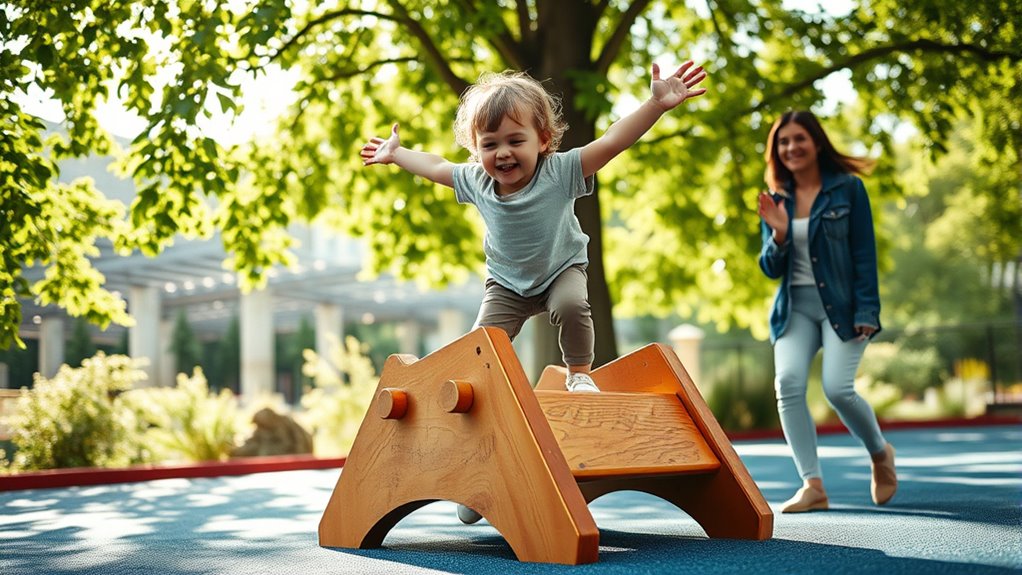Encouraging risk-taking in play helps children build confidence and resilience while learning to assess dangers safely. You can create an environment where they feel supported to explore within their developmental abilities. Ask questions that promote self-evaluation and guide them through challenging moments without removing all risks. By helping kids understand safety and learn from setbacks, you foster valuable problem-solving skills. Keep exploring ways to nurture their growth in confident, safe ways—there’s much more to discover ahead.
Key Takeaways
- Create a safe, supervised environment that encourages children to explore and try new challenges at their developmental level.
- Guide children through risk assessment by asking questions like “Do you think you can do this safely?” to promote self-evaluation.
- Offer manageable challenges that build confidence, gradually increasing difficulty based on the child’s abilities and progress.
- Allow children to experience setbacks, teaching resilience and problem-solving without immediate intervention.
- Foster open communication about risks and safety, helping children internalize safety while exploring their curiosity.

Encouraging risk-taking in play is essential for helping children develop confidence, resilience, and problem-solving skills. As a caregiver or educator, you play a vital role in creating an environment where children feel safe to explore their limits. One of the key ways to do this is by guiding them through risk assessment. Instead of simply preventing every potential danger, you teach children to evaluate risks themselves. For example, when they want to climb higher on a jungle gym, you can ask questions like, “Do you think you can do this safely?” or “What would you do if you felt unsure?” This process helps children learn to weigh potential hazards and develop their judgment skills, which is crucial for their overall growth.
Understanding developmental milestones is also critical. Every child reaches these milestones at different times, and recognizing where a child is in their development allows you to tailor risk-taking opportunities appropriately. For instance, a toddler just mastering walking might enjoy exploring low steps or soft climbing structures, while an older preschooler might be ready for more complex challenges like balancing on a beam or jumping from a low platform. By aligning play activities with their current abilities, you ensure they’re neither bored nor overwhelmed, fostering confidence as they succeed in new tasks. Encouraging children to push their boundaries within safe limits helps them experience success, which reinforces their self-esteem.
Recognize each child’s developmental stage to tailor safe, confidence-building risk-taking opportunities.
It’s also important to create a supportive atmosphere during play. When children fall or stumble, instead of immediately intervening, you can help them understand what went wrong and how to improve next time. This teaches resilience—showing that setbacks are part of learning rather than failures. You might say, “You didn’t quite make it, but that’s okay. Let’s try again together,” encouraging perseverance without discouragement. As children navigate these moments, they develop problem-solving skills, learning to adapt and think critically about how to approach similar challenges in the future.
Finally, fostering open communication about risks helps children internalize safety as a priority without stifling their curiosity. Talk with them about what they’re doing and why it’s exciting or challenging. When children feel trusted and supported, they’re more likely to take appropriate risks and learn from their experiences. Additionally, integrating insights from predictive analytics can help caregivers anticipate potential challenges and better tailor safe risk-taking opportunities. By balancing risk assessment, developmental understanding, and encouragement, you help children build the confidence they need to explore the world safely and boldly.
Frequently Asked Questions
How Can Parents Balance Safety and Independence During Risky Play?
You can balance safety and independence during risky play by conducting thorough risk assessments beforehand. Identify potential hazards and implement safety precautions like protective gear or supervised zones. Allow your child to explore within these boundaries, fostering confidence while minimizing danger. Encouraging safe risk-taking helps your child develop independence, resilience, and decision-making skills, all while ensuring you’re actively managing safety without stifling their natural curiosity and desire to challenge themselves.
What Signs Indicate a Child Is Ready for More Challenging Risks?
Imagine your child as a mountain climber preparing for a steeper ascent. Signs of risk readiness include their enthusiasm to try new challenges, steady balance, and persistence despite setbacks. Confidence indicators show they’re eager to take on more complex tasks, communicate their needs clearly, and recover quickly after falls. When they display enthusiasm and resilience, it’s a sign they’re ready to embrace more challenging risks safely and confidently.
How Does Risky Play Influence a Child’s Emotional Development?
Risky play helps boost your child’s emotional resilience by teaching them how to handle setbacks and manage fear. When they take on challenging activities, they build self-esteem development as they realize their abilities grow through effort. By supporting safe risks, you give your child opportunities to learn courage and independence, which strengthens their emotional well-being and prepares them for future challenges with confidence.
Are There Specific Activities That Promote Safe Risk-Taking?
You can promote safe risk-taking by introducing activities like climbing challenges, where children test their limits with supervision, and water-based activities that encourage exploration in a controlled environment. These activities help kids develop confidence and resilience while minimizing danger. Guarantee safety measures are in place, such as soft landings or life jackets, to support their growth and enjoyment without compromising safety.
How Can Caregivers Respond to a Child’s Fear of Taking Risks?
When your child fears taking risks, you can respond with patience and understanding. Use risk assessment to evaluate the activity’s safety, then provide emotional reassurance by acknowledging their feelings. Encourage small steps, praising their efforts to build confidence. Remind them that trying new things is okay and support them as they gradually overcome their fears, helping them feel secure while exploring new challenges.
Conclusion
By encouraging risk-taking in play, you’re planting seeds of confidence that grow stronger with each adventure. Remember, safety acts as the sturdy roots supporting your child’s daring spirit, allowing them to reach for new heights without fear. Embrace their curiosity like a guiding star, shining brightly even when they stumble. With your support, they’ll learn that the greatest growth often comes from taking the leap into the unknown, turning every challenge into a blossoming opportunity.










